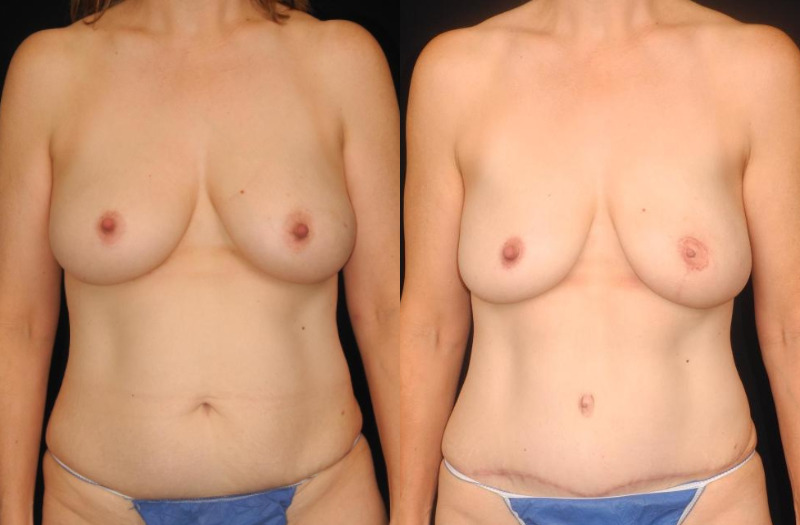On This Page
- What Is Diep Flap Reconstruction?
- Before & After Photos
- The Diep Flap Surgical Process
- Diep Vs. Other Breast Reconstruction Options
- Who Is A Candidate For Diep Flap Surgery?
- Reviews & Opinions Of Existing Patients
- Nipple Reconstruction & 3d Areola Tattooing
- Why Choose Snyder Plastic Surgery
- Frequently Asked Questions About Diep Flap Reconstruction
- Schedule A Consultation
- Additonal Information
- In The News
- Follow Us On Instagram
At Snyder Plastic Surgery, we understand that breast reconstruction is more than a procedure; it’s a deeply personal journey. For women facing mastectomy due to breast cancer or those proactively choosing prophylactic surgery because of a BRCA1 or BRCA2 mutation, DIEP flap reconstruction offers a natural, lasting solution using your own tissue.
By transferring abdominal skin and fat, this technique creates a soft, lifelike breast without implants, avoiding the need for long-term maintenance or replacement. For BRCA+ patients pursuing preventive surgery, DIEP flap can provide peace of mind and restored confidence.
Dr. Ned Snyder IV, a board-certified plastic and reconstructive surgeon, leads a team that collaborates closely with genetic counselors, oncologists, and breast surgeons to provide seamless, multidisciplinary care in Austin and Round Rock, Texas.
What is DIEP Flap Reconstruction?
DIEP stands for Deep Inferior Epigastric Perforator, referring to the blood vessels used to transfer skin and fat from the lower abdomen to the chest to reconstruct the breast. Unlike older procedures like the TRAM flap, the DIEP technique preserves the abdominal muscles, resulting in less postoperative pain, faster recovery, and retained core strength.
This autologous reconstruction (meaning it uses your own tissue) offers a soft, warm, and natural-looking breast without the need for implants.



Real Results, Real Healing
Before & After Photos
Browse before and after photos to see how DIEP flap reconstruction has helped real patients restore their confidence and achieve natural-looking results after mastectomy.
VIEW OUR GALLERYThe DIEP Flap Surgical Process
DIEP flap breast reconstruction involves several stages, beginning with a detailed consultation and continuing through surgery and recovery. Understanding what to expect at each step can help you feel more prepared and confident as you plan for your procedure. The outline below walks through the key phases before, during, and after surgery.
DIEP Flap Reconstruction Step-by-Step

Pre-Reconstruction, Post-Mastectomy

Reconstructive Process

Post-Reconstruction

Pre-Reconstruction, Post-Mastectomy
Before undergoing DIEP flap breast reconstruction, you will meet with Dr. Ned Snyder IV and the Snyder Plastic Surgery team for a detailed consultation. During this time, your overall health, surgical history, and goals for reconstruction will be thoroughly evaluated.
Many patients coordinate with their oncology team, especially when reconstruction follows a cancer diagnosis or occurs during a prophylactic mastectomy.. Imaging and physical assessments help determine whether you are a good candidate for the procedure. You’ll also receive instructions on how to prepare, including managing medications, quitting smoking if applicable, and arranging for postoperative support at home.

Reconstructive Process
The DIEP flap procedure involves transplanting skin and fat from the lower abdomen to reconstruct the breast while preserving the abdominal muscles. This is a highly specialized microsurgical technique that requires identifying and reconnecting tiny blood vessels. The average surgery time is about 2–3 hours for a single breast (unilateral) and 4–6 hours for both breasts (bilateral).
An incision similar to a tummy tuck is made across the lower abdomen, allowing the tissue to be removed and reshaped into a natural-looking breast mound. Drains are placed in both the abdominal and chest areas to prevent fluid accumulation. One of the key advantages of this technique is that the abdominal muscles remain intact, allowing patients to retain core strength after healing.

Post-Reconstruction
After the procedure, patients are typically admitted to the Intermediate Care Unit (IMC) or Intensive Care Unit (ICU) for close monitoring. Specialized sensors are placed on the breast to continuously monitor blood flow to the flap and ensure successful healing. Most patients stay in the hospital for 3 to 5 days.
Once discharged, patients will be instructed on how to care for their drains, which usually remain in place for 1 to 3 weeks. Initially, the drainage fluid is dark red, gradually lightening in color as healing progresses. Drains are removed once output decreases to below 30cc in a 24-hour period.
The early recovery period is marked by fatigue, tightness in the abdomen, and general soreness. Most patients begin to feel more energetic within 2 weeks and can resume light daily activities. However, heavy lifting and strenuous exercise should be avoided for 4 to 6 weeks. Over time, the reconstructed breast softens and settles into a natural shape, offering a long-term result that looks and feels remarkably similar to a natural breast.
Recovery periods vary for each patient. Typically, you are sore and tired easily for the first few weeks after surgery. After 2 weeks, you will notice an increase in energy levels each day. Generally, heavy lifting and strenuous activity should be avoided for at least 4 – 6 weeks after the procedure.
DIEP vs. Other Breast Reconstruction Options
Choosing the right type of breast reconstruction is a deeply personal decision. At Snyder Plastic Surgery, we ensure our patients are fully informed about their options. While DIEP flap reconstruction offers a natural, muscle-preserving approach, it’s important to understand how it compares to other common techniques:
- TRAM Flap: Uses abdominal muscle, which can weaken the core and lengthen recovery.
- Implants: Faster initial recovery but involve foreign materials, rupture risk, and future replacements.
- SIEA / GAP Flaps: Alternative tissue sources for those who aren’t candidates for DIEP.
Dr. Snyder will discuss these options during your consultation to determine the best reconstructive approach for your body and goals.
Featured Video
What is a DIEP Flap?
Learn more from Dr. Ned Snyder
Who Is a Candidate for DIEP Flap Surgery?
You may be a candidate for DIEP flap breast reconstruction if:
- You’ve had or are planning to have a mastectomy (due to breast cancer or prevention).
- You carry a BRCA1 or BRCA2 genetic mutation and are considering prophylactic mastectomy.
- You have sufficient abdominal tissue for the flap.
- You are in good overall health without conditions that impair healing (e.g., smoking, uncontrolled diabetes).
- You are seeking natural breast reconstruction without implants.
Both immediate reconstruction (at the time of mastectomy) and delayed reconstruction (after treatment or healing) are options depending on your personal and medical situation.
our reputation Reviews & Opinions Of Existing Patients
patient reviewsNipple Reconstruction & 3D Areola Tattooing
For many patients, the final stage of breast reconstruction includes restoring the nipple and areola. While this step is entirely optional, it can have a significant emotional and aesthetic impact.
Surgical Nipple Reconstruction
This procedure involves creating a small projection using the reconstructed breast skin to form a nipple shape. Once healed, the area can be tattooed to resemble the natural areola.
3D Areola Tattooing
This advanced tattooing technique uses shading and color gradients to create a realistic, three-dimensional appearance of the areola. It can be done with or without surgical nipple creation.
Our team works closely with trusted providers to offer both options and will guide you through the decision-making process. For many women, completing this step helps restore a sense of wholeness and closure in their journey.
Why Choose Snyder Plastic Surgery
At Snyder Plastic Surgery, patients benefit from the expertise of Dr. Ned Snyder IV, a board-certified plastic surgeon with specialized training in microsurgical techniques like the DIEP flap. Known for his experience and precision, Dr. Snyder has performed hundreds of successful breast reconstructions.
Our team is committed to providing compassionate, personalized care throughout every step of your journey. From consultation to recovery, we focus on safety, support, and natural-looking results. With locations in Austin and Round Rock, we’re proud to serve patients seeking advanced, trusted breast reconstruction options.
Frequently Asked Questions About DIEP Flap Reconstruction
Am I a candidate for DIEP flap breast reconstruction in Austin, TX?
How is the DIEP flap reconstruction procedure performed at Snyder Plastic Surgery?
What is the recovery timeline after DIEP flap reconstruction in Austin?
Will I need additional surgeries after my initial DIEP flap reconstruction?
How do DIEP flap results compare to other breast reconstruction options in Austin?
Will I have scars after DIEP Flap Reconstruction?
Can DIEP be done immediately after mastectomy?
Does DIEP Flap Reconstruction affect abdominal strength?
Schedule a Consultation
Discover the transformative benefits of DIEP flap breast reconstruction with the experienced team at Snyder Plastic Surgery. Whether you’re healing after cancer or planning preventive care, we’re here to support you with expertise, compassion, and personalized attention.
learn more Additonal Information
For additional information about our services, procedures, and the patient experience at Snyder Plastic Surgery, please explore our website or contact our office. We are committed to providing comprehensive care and support from the initial consultation through recovery. Schedule a consultation today to begin your journey towards a more confident and beautiful you.







